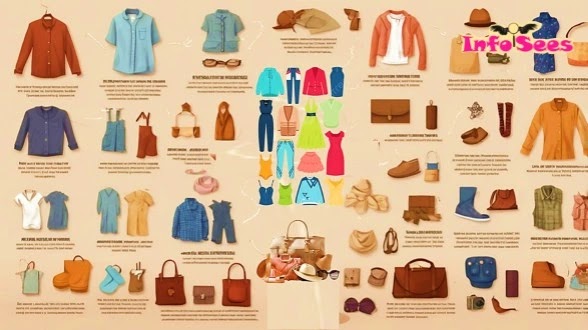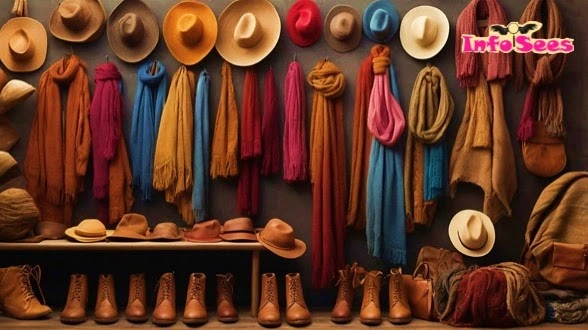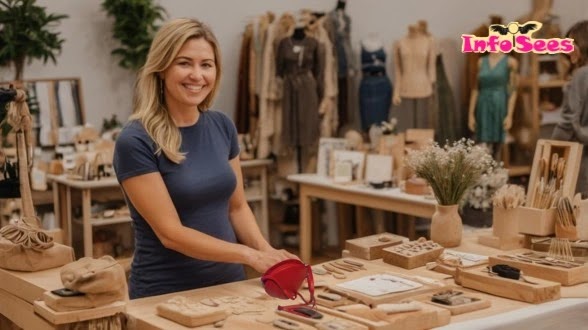
Many people appreciate handmade clothing and accessories for their uniqueness, craftsmanship, and personal touch.
Some skilled artisans have turned this demand into a profitable business by designing and selling customized clothing and accessories.
This is known as the handmade clothing and accessories business, where fabric, creativity, and craftsmanship come together to create personalized and stylish products tailored to the individual customer's needs.
Let's find out what Handmade Clothing and Accessories Business is?

Handmade Clothing and Accessories Business Introduction?
The handmade clothing and accessories business is a growing industry that combines creativity with craftsmanship.
Unlike mass-produced fashion, handmade items have a unique appeal, showcasing the artist's skill, attention to detail, and passion for design.
Handmade clothing and accessories include a wide range of products, such as custom-stitched dresses, hand-knitted sweaters, embroidered scarves, beaded jewelry, leather wallets, and eco-friendly handbags.
Many consumers appreciate handmade items because they are unique, sustainable, and often made with high-quality materials.
With online marketplaces, social media, and the growing interest in personalized fashion, starting a handmade clothing and accessories business has never been more profitable.
Whether you’re a skilled artisan or a beginner looking to monetize your craft, this guide will provide everything you need to know to establish a successful handmade clothing and accessories business.
How To Earn Money in Handmade Clothing and Accessories Business?
Earning money in a handmade clothing and accessories business requires strategic planning and multiple income streams.
Here are some key ways to monetize your business:
1. Sell on Online Marketplaces
Platforms like Etsy, Amazon Handmade, eBay, and Shopify offer great opportunities to reach a global audience. Create a professional-looking shop with high-quality images, engaging descriptions, and competitive pricing.
2. Launch Your Own Website
Building your own e-commerce website allows full control over branding, pricing, and customer interaction. Use platforms like Shopify, WooCommerce, or Wix to create an online store. Optimize your site for SEO to attract organic traffic.
3. Social Media Selling
Utilize Instagram, Facebook Marketplace, Pinterest, and TikTok to showcase and sell your handmade products. Collaborate with influencers and fashion bloggers to promote your brand.
4. Sell at Local Markets and Events
Participate in craft fairs, flea markets, fashion expos, and pop-up shops to sell directly to customers. Engage with customers to build relationships and gain valuable feedback.
5. Offer Custom and Personalized Orders
Many customers love personalized designs, such as monogrammed handbags, customized dresses, and unique jewelry pieces. Providing bespoke services can increase customer loyalty and referrals.
6. Wholesale and Bulk Orders
Partner with boutiques, specialty stores, or fashion retailers to supply handmade products in bulk. Focus on branding and packaging to attract high-end buyers.
7. Online Courses and Workshops
If you are highly skilled, consider teaching others by offering online courses, workshops, or paid tutorials on platforms like Udemy, Skillshare, or YouTube.
8. Subscription Boxes and Memberships
Offer a monthly subscription box where customers receive handmade accessories or DIY kits. Create an exclusive membership with discounts and early access to new collections.
Who Can Start Handmade Clothing and Accessories Business?
Anyone with a passion for fashion:
Anyone with a passion for fashion and crafting can start a handmade clothing and accessories business, whether you are skilled or just starting out. Dedication and creativity are key to success in this field.
Creative entrepreneurs:
Entrepreneurs who love creating unique products can turn their creativity into a handmade clothing and accessories business.
Stay-at-home parents or caregivers:
Starting a handmade clothing and accessories business offers flexibility to stay-at-home parents or caregivers who want to earn income while looking after their families.
Artisans and craftspeople:
Skilled artisans who specialize in sewing, knitting, crochet, jewelry making, or other crafts can use their expertise to start a handmade clothing and accessories business.
How To Start a Profitable Handmade Clothing and Accessories Business?
Step 1: Identify Your Niche
Decide whether to focus on women’s clothing, men’s fashion, children’s wear, jewelry, handbags, or eco-friendly accessories. Research current trends and customer preferences.
Step 2: Develop Your Skills
Take sewing, knitting, embroidery, or jewelry-making courses to refine your craft. Learn about fabric selection, color combinations, and fashion trends.
Step 3: Source Quality Materials
Find reliable suppliers for fabrics, beads, threads, leather, or eco-friendly materials. Consider using recycled or organic materials to attract eco-conscious buyers.
Step 4: Create a Business Plan
Outline your target audience, pricing strategy, marketing plan, and financial goals. Set a budget for raw materials, branding, and advertising.
Step 5: Register Your Business
Choose a business name and register it legally. Obtain the necessary permits and licenses if required in your country.
Step 6: Set Up Your Selling Platforms
Create an online store, social media pages, and list products on marketplaces. Use professional photography to showcase your products attractively.
Step 7: Market Your Brand
Use SEO, social media marketing, and influencer collaborations to build brand awareness. Run discounts and promotional offers to attract first-time buyers.
Step 8: Manage Orders and Customer Service
Use order management tools like Shopify, Etsy, or Trello to track sales. Provide excellent customer service to build long-term relationships.
Step 9: Scale Your Business
Expand product lines and collaborate with other artisans. Invest in branding, packaging, and advertising to grow your brand.
Types of Handmade Clothing and Accessories Business?
Handmade Clothing:
Custom dresses, T-shirts, hoodies, hand-knitted sweaters.
Jewelry:
Beaded necklaces, handmade earrings, wire-wrapped rings.
Bags and Purses:
Leather handbags, crochet bags, eco-friendly totes.
Scarves and Shawls:
Embroidered scarves, hand-painted shawls.
Headwear:
Handwoven hats, embroidered caps, hair accessories.
Footwear:
Hand-stitched leather sandals, customized sneakers.
Baby and Kids' Wear:
Handmade rompers, baby blankets, knitted socks.
Handmade Clothing and Accessories Business Successful Tips
Create Unique Designs:
Avoid copying trends; focus on originality.
Quality Over Quantity:
Handmade products should be durable and well-crafted.
Branding Matters:
Invest in logo, packaging, and consistent social media aesthetics.
Engage with Customers:
Offer personalized experiences and prompt responses.
Stay Updated:
Keep track of fashion trends and customer demands.
Offer Discounts and Loyalty Programs:
Encourage repeat customers with special deals.
Use Customer Reviews:
Showcase positive testimonials to build trust.
Knowledge and Considerations You Need to Know
Time Management:
Handmade production takes time; plan schedules wisely.
Pricing Strategy:
Consider material costs, labor, and profit margins when pricing.
Legal Aspects:
Register your brand and check for copyright issues.
Shipping and Logistics:
Research the best shipping options for domestic and international customers.
Financial Planning:
Track expenses, profits, and reinvest for growth.
Customer Preferences:
Keep an eye on seasonal trends and fashion preferences.
Related Blog Post Topics
Coming Soon.
Conclusion
Starting a handmade clothing and accessories business is a rewarding journey that combines passion and creativity with entrepreneurship. With the right strategy, quality expertise, and effective marketing, you can turn your skills into a profitable business.
Focus on providing high-quality, unique products and building strong relationships with your customers to stand out in this competitive industry. If you are consistent and adaptable, success in the world of handmade fashion is within your reach!
Frequently Asked Questions (FAQs)
What is the future of this field?
The future of handmade clothing and accessories is bright as people choose sustainability and ethical fashion over fast fashion, driving growth in this area.
How can I purchase handmade clothing and accessories from your collection?
Shop directly from our online store or visit us at local craft fairs and markets to check out our latest designs.
Can I request custom-made or personalized items from your collection?
Yes, we offer custom-made options to suit your preferences and needs.
Do you offer plus-size options in your handmade clothing collection?
Yes, we offer a range of sizes to ensure everyone can find something that fits and feels great.
How can I stay updated on new arrivals and promotions from your handmade clothing and accessories collection?
Subscribe to our newsletter, follow us on social media, or visit our website to stay updated on new arrivals and special offers.
Disclaimer
This blog post is for general information, awareness, knowledge and educational purposes only. Always, it is better to check the latest updates and do more research and consult experts to get complete details. The author and publisher do not assume any responsibility or liability for any actions taken based on the information provided in this blog post.
If you find any mistake or error in this article, please let us know and also give suggestions to correct it.
Thank you for coming.
See you soon in another part.








Post a Comment
Post a Comment